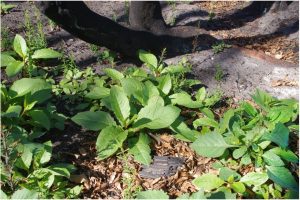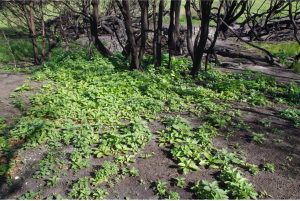Connect with us
By Michele Kohout, Pat Coupar and Max Elliott
Inkweed, native to tropical South and Central America, has found a strong foothold in Australia, particularly in disturbed areas such as roadsides, creek lines and cleared land. And it has made a prominent appearance in Mallacoota since the fires.
This short-lived perennial can grow up to two metres tall, with a tuberous taproot and fibrous lateral roots. It produces small greenish-white flowers, followed by distinctive red berries that yield an ink-like juice—historically used as a dye. Remarkably, inkweed can produce fruit year-round, making it a resilient and persistent species.
Aided by Birds and Fire

Birds, especially Silvereyes and Satin Bower Birds, play a crucial role in spreading inkweed. After consuming the berries, their digestive processes help dissolve the seed coat, significantly increasing germination success—studies show an impressive 96% viability rate after passing through Silvereyes. Foxes also contribute to dispersal by spreading seeds in their droppings.
However, inkweed seeds require heat to germinate effectively, often lying dormant in the soil until a fire event triggers their growth. Following low-intensity fires, inkweed emerges in large numbers, matures quickly, and produces vast amounts of seeds. It is so successful at reestablishing itself that one researcher described it as an “aggressive pioneer.” Some seeds may remain viable in the soil for up to 14 years, making long-term management challenging.
A Noxious Past and a Weedy Future?
Inkweed was declared a noxious weed in Australia as early as 1907, but its classification has changed over time. It is no longer officially listed as a noxious species, likely due to its widespread distribution, making enforcement difficult.

However, in Victoria, it remains an environmental weed with a high-risk rating for control. It is found in every Australian state and territory except the Northern Territory, with the heaviest concentration along the east coast of New South Wales, particularly at elevations between 200 and 1000 metres.
Managing Inkweed in Post-Fire Landscapes
Bushcare Mallacoota has been actively working to control inkweed using herbicide treatments such as glyphosate (Bayer RoundUp®) combined with a surfactant. Early results indicate success in eliminating seedlings and young plants. However, larger, flowering plants may require additional treatments, and it remains to be seen whether they will die off completely or resprout.
Interestingly, one site with dense Melaleuca regeneration has been left untreated to observe whether native species can outcompete inkweed over time. While young seedlings can be removed manually, mature plants develop a strong taproot that makes them more difficult to eradicate, as they often break off and regrow.
A Race Against Time
One of the biggest concerns is inkweed’s rapid growth. Within just a month of germination, it can begin flowering and setting seed, making timely intervention crucial. Before recent fires, local conservation groups had not considered inkweed a major issue in Mallacoota. However, the outbreak following the fire has highlighted the urgent need for control measures to prevent it from outcompeting native vegetation.
As researchers and conservationists continue to monitor inkweed’s spread, one thing is clear: fire creates opportunities for this resilient plant, and without proactive management, it could become a dominant force in post-fire landscapes.